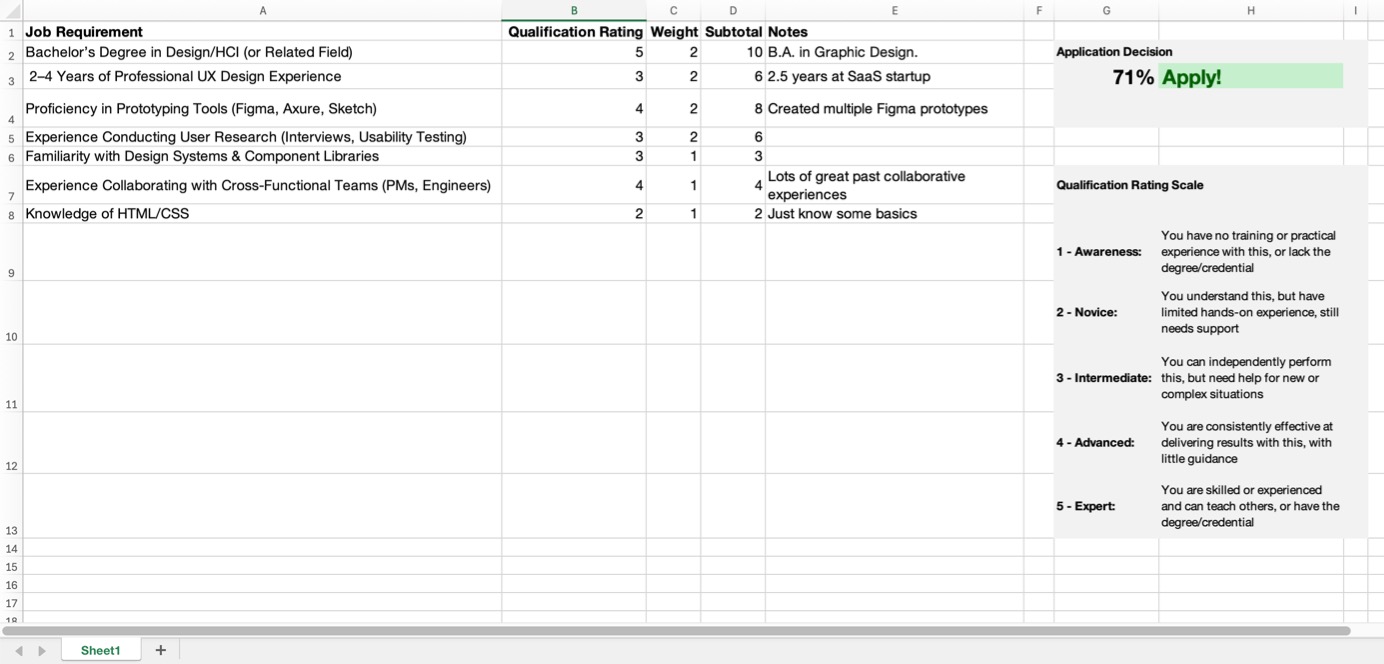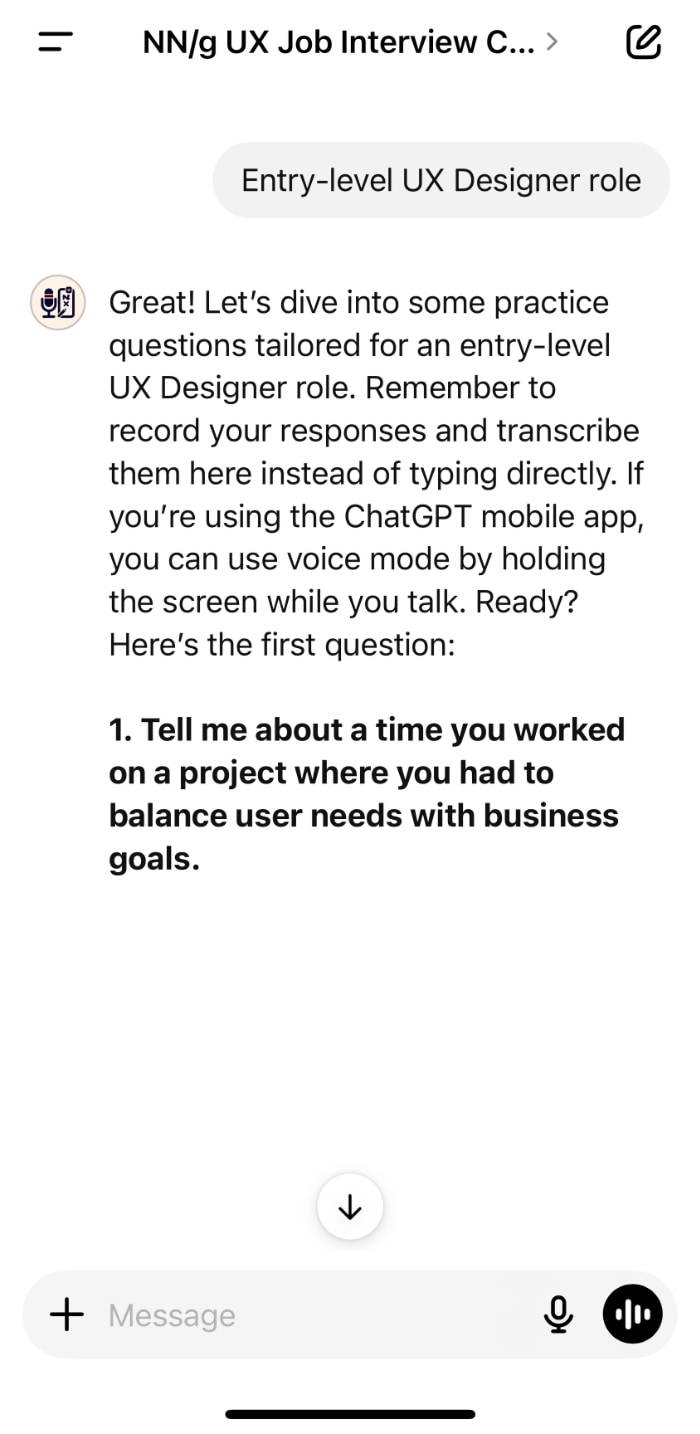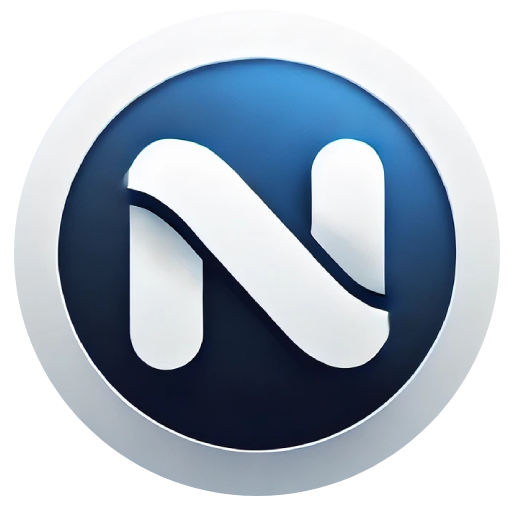Summary:
Leverage your human mind — not a machine — in your UX job search with these simple communication templates and tools.
Here is a list of communication templates and other tools to help you in your job-search process. Use these resources together with these articles on UX job searching advice:
A Note on Using Generative AI
These communication templates concisely illustrate the essential elements that your message should contain for each situation. Although you could use generative AI (genAI) to write these messages, that tool doesn’t know you, your circumstances, or your contacts. Your personal touch — which can only be performed by you — will express care and thoughtfulness to the recipient and increase the likelihood of a favorable response (your recipients will be conditioned by the generic, machine-generated slop used by everyone else). Use genAI only as a proofreader or light editor of an authentic message drafted by you.
Message to Notify Your Professional Network of Your Job Search
Here’s a message to let your professional connections know that you’re looking for new job opportunities. Whenever possible, highlight a recent event about them (perhaps easily found on LinkedIn or another social media account) and then transition into a simply stated request about your job search.
Hi [Contact Name],
I hope life has been treating you well! I know it’s been a while since we last spoke, but I noticed you just took a job as Lead UX Designer at AcmeCorp. Congratulations! I hope you’ve been enjoying it so far.
As for me, I’m currently in the market for a new UX job. Ideally, I’m looking for senior UX roles in the financial industry, but if you know of any UX job opportunities or hiring managers with potential openings, I’d greatly appreciate hearing about them.
Let me know how you’re doing, and thanks in advance for any leads.
Best wishes,
[Your Name]
Message Asking for a Reference
References are often an overlooked resource you sometimes need during the hiring process. This message asks someone for their agreement to serve as a reference for you (ideally a former boss or dependable close collaborator). Your message to a potential reference should be concise, lead with something positive about the recipient, and request permission to use them as a reference (now or later). Follow this example:
Hi [Reference Name],
How have you been lately? I was thinking about you recently because I’m currently searching for a job, and some employers ask for professional references. Your name came to me because of all the great design work we did together at [Company Name].
Could I count on you to be a professional reference in the future? I don’t have a job opportunity asking for references right now, but when I do, I’ll contact you in advance and let you know of any instructions about the process.
I hope you’ll consider it, and I’d be happy to serve as a reference for you if you ever need it.
Thanks,
[Your Name]
Determine Your Professional Values
Rushing into a new UX job based on job title, employer, or compensation is a recipe for dissatisfaction once the newness wears off (which happens in the span of months, not years). When was the last time you reflected on your UX career and your motivation for doing it? These free surveys and exercises can help you self-reflect and calibrate your job search towards job opportunities you’d gladly accept instead of wasting time on those you’ll regret:
Message to a Potential Mentor
A mentor can be an invaluable resource of advice and perspective during your UX job search. But quality mentorship isn’t just a handful of brief sessions, it’s a commitment that lasts months, or even years. Good mentors are likely busy and will protect their time, so they will be selective about who they partner with in such a long-term arrangement.
In your message, introduce yourself, demonstrate your awareness of their work, and convey why you think they’d be a good mentor for you and your goals. Only directly request a mentorship in your message if you have connection and rapport with this potential mentor. The less you personally know them, the more you should reduce your initial request to a brief Q&A introduction and then build up to a verbally delivered mentorship request.
Hi [Potential Mentor Name],
My name is [Your Name] and I’m an aspiring UX designer changing careers from front-end development into user experience. My current boss, [Mutual Contact Name], mentioned how you made a similar career change while at [Mutual Company Name] and spoke highly of your UX work there.
If you have availability in the next couple of weeks, I’d greatly appreciate the opportunity to learn about your experiences and get advice for someone on a similar journey. Would you be open to a 20-minute Zoom chat? If your schedule is full right now, I completely understand. I’m flexible and happy to find a date and time that works best for you.
Thanks for your time and I hope we can connect,
[Your Name]
Don’t have a potential mentor in your professional network? Try these mentorship resources:
Job-Requirement Decision Aid
This decision aid will help you make a more balanced and accurate determination if you are qualified for a UX job. Follow these steps to use it when reviewing a job posting:
- In the Job Requirement column: copy and paste all requirements from the job posting.
- In the Weight column: assign a 2 to each requirement listed as must-have or required. Assign a 1 to all remaining requirements, which should be listed as nice-to-have or preferred.
- For each requirement, review your qualifications and consider your past experiences. Refresh your memory with your resume or portfolio, if necessary. Then assign a Qualification Rating:
- Awareness (1): You have no training or practical experience, or you lack the degree/credential.
- Novice (2): You understand the requirement, but have limited hands-on experience, still needs support.
- Intermediate (3): You can independently perform this task but need help in new or complex situations.
- Advanced (4): You are consistently effective at delivering results , with little guidance.
- Expert (5): You are skilled or experienced and can teach others, or you have the degree/credential.
- Optional: try writing down a few words to justify your score; these might jog your memory and influence the rating you give.
When finished, the spreadsheet will score your answers and tell you if it’s worth your time to apply.

Knowledgeable UX Recruiters
Recruiters can support your UX job search by surfacing additional UX job opportunities. Not all recruiters are the same, though, and you want to use ones that are knowledgeable, experienced, and well-connected in filling in UX roles, such as these:
Message About Withdrawing from a Job-Application Assessment
You may encounter UX hiring managers who request assessments that demand more time and effort than you are willing to invest for a job offer. For example, they request an extensive design review of an app, and you estimate it would take you days to complete.
Don’t complain, don’t attempt to negotiate not doing it, and don’t offer substitute submissions that would be easier for you to do. In all these cases they either reflect poorly on your professionalism or, if the UX hiring manager relents, it’s a sign they don’t know how to hire for their UX team (and a clue that this manager may not be the best to learn and grow from).
Withdraw from consideration with this diplomatic message to the hiring manager:
Hi [UX Hiring Manager Name],
Thank you for sharing the details about this assessment. After some reflection, I’ve realized that, due to my commitments, I won’t be able to dedicate the time needed for the next steps.
Out of respect for your time and effort, I’ve decided to withdraw my application. Thanks again for this opportunity, and I hope you find an excellent candidate for your UX team!
Best wishes,
[Name]
A Thank-You Note to Interviewers
Sending a brief thank-you note to your interviewers won’t win you the job, but these notes do provide 3 subtle advantages: they are evidence of effort and desire for a job offer, they confirm you were paying attention during the interview, and they afford you another chance to reiterate your qualifications.
This message requires taking a few notes during or after the interview to track these details. Confirming your interviewer’s work email after the interview is also helpful so you can send your note (but feel free to ask the UX hiring manager or HR recruiter if you need to remember).
Hi [Interviewer Name],
Thank you for taking the time to interview me yesterday for the UX researcher role. As a fellow UX-career switcher, learning about your successful career transition from product management into UX was inspiring!
Based on your questions, [Company Name] seems to be trying to improve recruiting users for research and testing. I believe my prior experience as a marketing coordinator — where I managed outreach campaigns, customer newsletters, and customer databases — could engage more users for UX research. I hope to get the opportunity to show what I can do and help at [Company Name].
Thanks again,
[Your Name]
Message Asking an Interviewer for Feedback
It’s difficult to improve your interviewing skills when you rarely receive feedback on your performance. A few UX hiring managers or interviewers might graciously share some tips with you, but most will not for myriad reasons. However, you might get lucky by sending a professional message like this one:
Hi [UX Hiring Manager / Interviewer Name],
Thank you for considering me for the UX role at [Company Name] and informing me of your decision. It was a great opportunity to learn more about your UX team and the exciting work you’re doing with [work they mentioned during interview].
If you have a moment, could you please share one piece of feedback that might help me improve my portfolio, resume, or interview performance going forward? I’m eager to learn from this experience and make some adjustments. Of course, I completely understand if you’re unable to provide feedback.
Thanks again for your time and consideration. I wish you and the UX team at [Company Name] continued success.
Best wishes,
[Your Name]
GPT for Practicing Answering Interview Questions
If your requests for interview feedback are frequently unsuccessful, then try the NN/g UX Job-Interview Coach on your phone. (It requires a ChatGPT account; using it does not require a paid account, but usage may be limited). This custom GPT will evaluate the quality of your answers to a series of past behavioral interview questions for UX roles. Here’s how to use it:
- Start a new chat with this custom GPT.
- Prompt it with the type of UX role you are seeking (user researcher, UX designer, UX leadership, etc.)
- After it asks you a question, press the rightmost button to activate voice mode. Then, press and hold the screen and speak aloud as if you were answering an interviewer. Pressing the screen prevents the custom GPT from interrupting or prematurely evaluating your answer.
- Release the screen when finished answering.
Custom GPTs are currently limited to using OpenAI’s original voice mode, so the interview will not naturally flow like with its more advanced voice mode. But, unlike casual chats with ChatGPT or other genAI tools, this custom GPT has extensive instructions to give you actionable feedback on your specific answers based on best practices.

Message for Declining a Job Offer Professionally
Sometimes a job offer doesn’t align with your professional interests, and you need to turn it down. Always do this professionally, as you want to preserve the professional relationship and avoid reputational damage.
Contact the UX hiring manager as quickly as possible: arranging a very brief phone call or video chat softens a disappointing message, especially if the UX hiring manager verbally extended the job offer to you in the first place. In other situations, a concise and respectful message over email works, especially when you reiterate that you’re trying to inform them quickly so they can move on other candidates.
Hi [UX Hiring Manager Name],
Thank you so much for the job offer. This experience was a great opportunity to learn more about [Company Name] and your UX team.
However, I need to decline your job offer at this time. My current career goal is to manage design systems, and I’m prioritizing opportunities that really focus on this area. Please keep me in mind for future opportunities that may be a better fit.
I hope that this prompt message will enable you to pursue other candidates. Thanks again for your time and consideration. I wish you and the [Company Name] UX team continued success.
Sincerely,
[Name]
